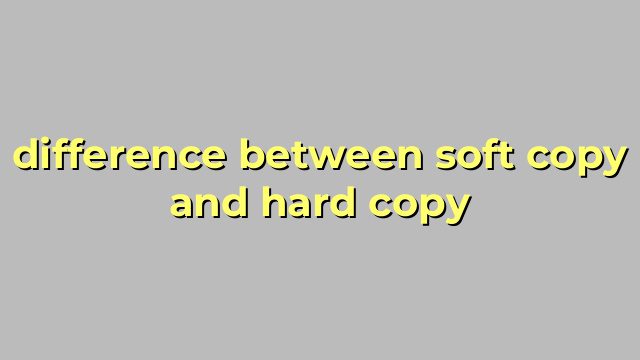The Difference Between Soft Copy and Hard Copy
Introduction
In today’s era of digitalization, we often come across two widely used terms, soft copy and hard copy. These terms refer to the form or medium in which a document is created or stored. Although the difference between these two types of documents may seem apparent, it is essential to understand the pros and cons of each. In this article, we will discuss the significant differences between soft copy and hard copy.
What is Soft Copy?
A soft copy refers to an electronic or digital version of a document or file. Soft copies are created and stored in digital format, and they can be easily modified, shared, and stored on electronic devices such as computers, tablets, or smartphones. They are often sent via email or shared through cloud services like Google Drive or Dropbox.
What is Hard Copy?
Hard copies refer to a tangible or physical version of a document or file. These versions are printed on paper or other hard material and are physically stored or filed. They are suitable for long-term storage and often used in official documents, contracts, or certificates that require physical signatures.
The Pros and Cons of Soft Copy
Soft copies have many advantages over hard copies. They are portable and can be accessed from electronic devices like laptops or smartphones, making them easy to share and edit. Multiple users can access and work on the same document simultaneously, reducing the need for printing, and saving time and paper. They are also environmentally friendly and reduce the carbon footprint of an organization.
However, soft copies also have potential drawbacks. They are susceptible to hacking, identity theft, and viruses that can compromise confidential information. They require electronic devices to access and can be lost or deleted if not properly stored or backed up.
The Pros and Cons of Hard Copy
Hard copies also have advantages over soft copies. They are durable, long lasting, and safe from electronic threats. They are also suitable for legal or official documents that require physical signatures.
However, hard copies are not as portable as soft copies and can be easily lost, damaged or destroyed in case of natural disasters like floods or fires. They require physical space for storage that can be costly and can quickly pile up, ultimately leading to more paperwork.
Conclusion
In conclusion, the choice between soft copy and hard copy primarily depends on the nature of the document and the intended use. Soft copies are perfect for documents that require frequent sharing, distribution, and editing, while hard copies are the go-to for legal or official documents that require physical signatures. Ultimately, the decision is based on personal preference and convenience. It is essential to consider the pros and cons of each option before making a final decision.
Table difference between soft copy and hard copy
| Attribute | Soft Copy | Hard Copy |
|---|---|---|
| Definition | An electronic version of a document that is saved on a computer or other digital device. | A physical printout of a document or image that is made using a printer or other printing device. |
| Storage | Stored digitally on a hard drive, cloud storage, or other digital storage medium. | Stored physically in a file folder, binder, or other type of storage container. |
| Portability | Can be easily transported on a portable device such as a USB drive or emailed to someone. | Can be physically carried but can be bulky or heavy. |
| Archival life | Can be lost or damaged if not properly backed up, but can be stored indefinitely if properly backed up and stored. | Can be lost, damaged, or destroyed due to fire, floods, or other disasters, but can last for decades if properly stored. |
| Copies | Can be easily duplicated and distributed with no loss of quality. | Each copy must be physically printed, which may cause a loss of quality over time. |
| Cost | Generally cheaper to produce and distribute, as there are no printing or shipping costs. | Printing and shipping costs can add up, especially for large documents or images. |

